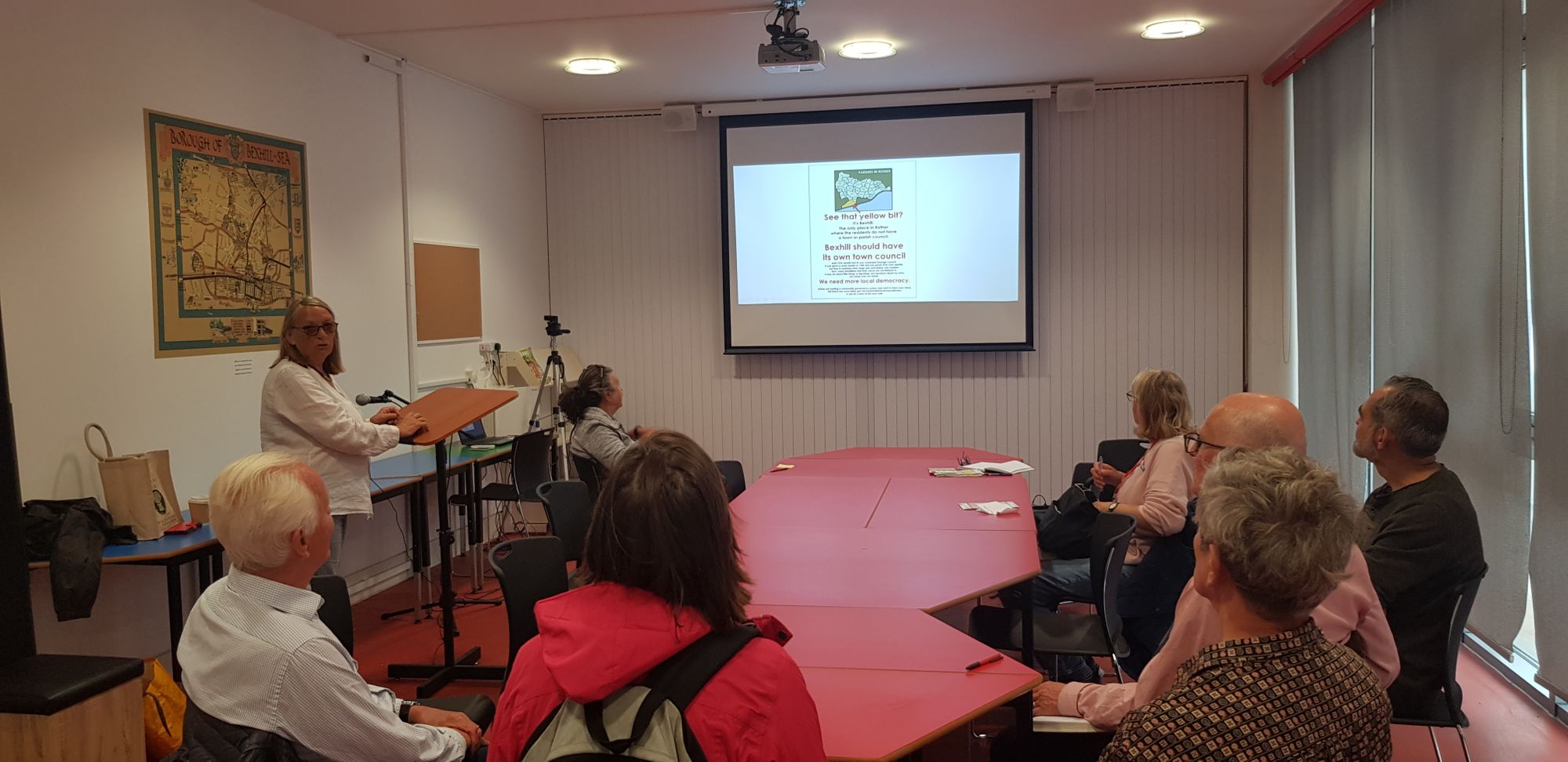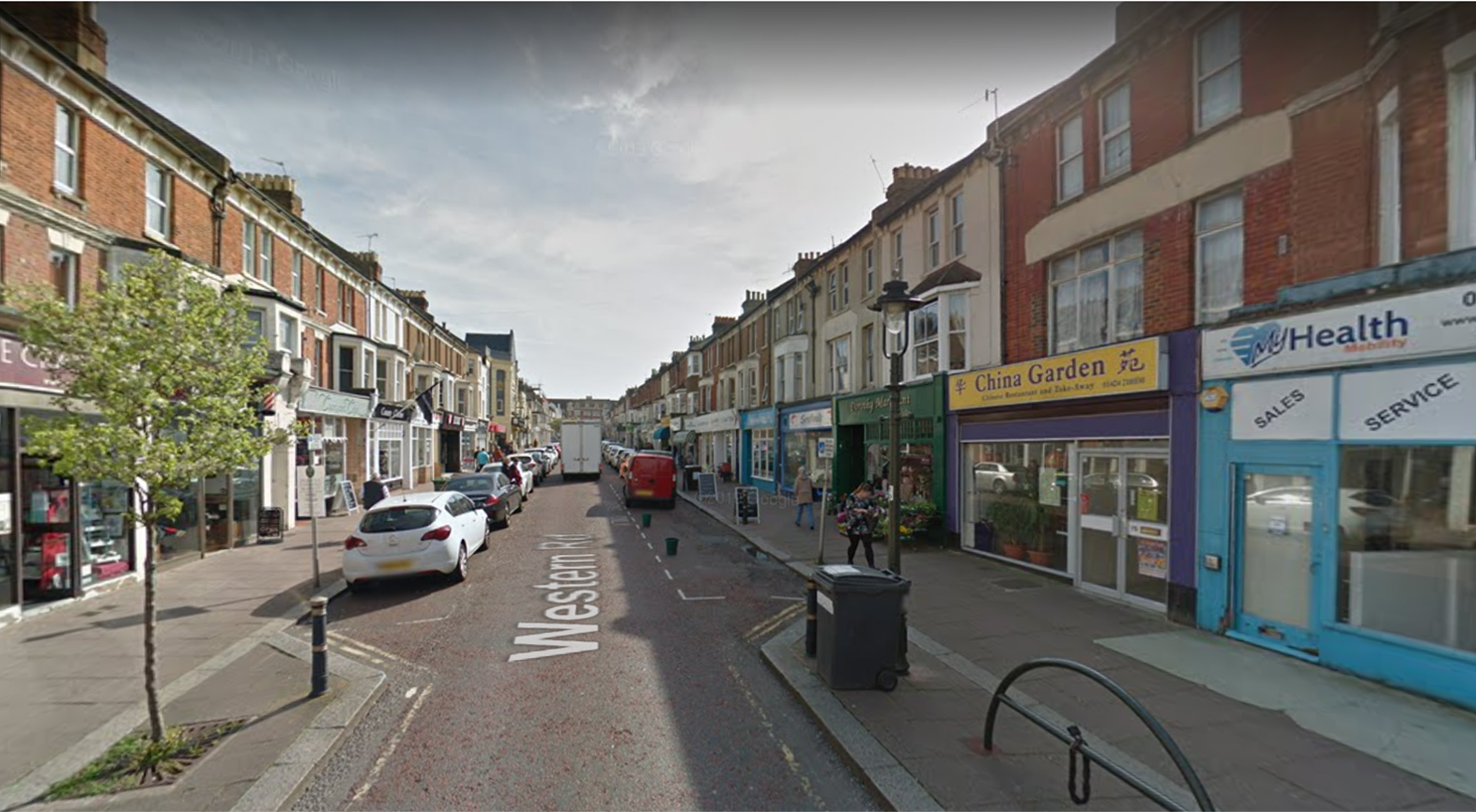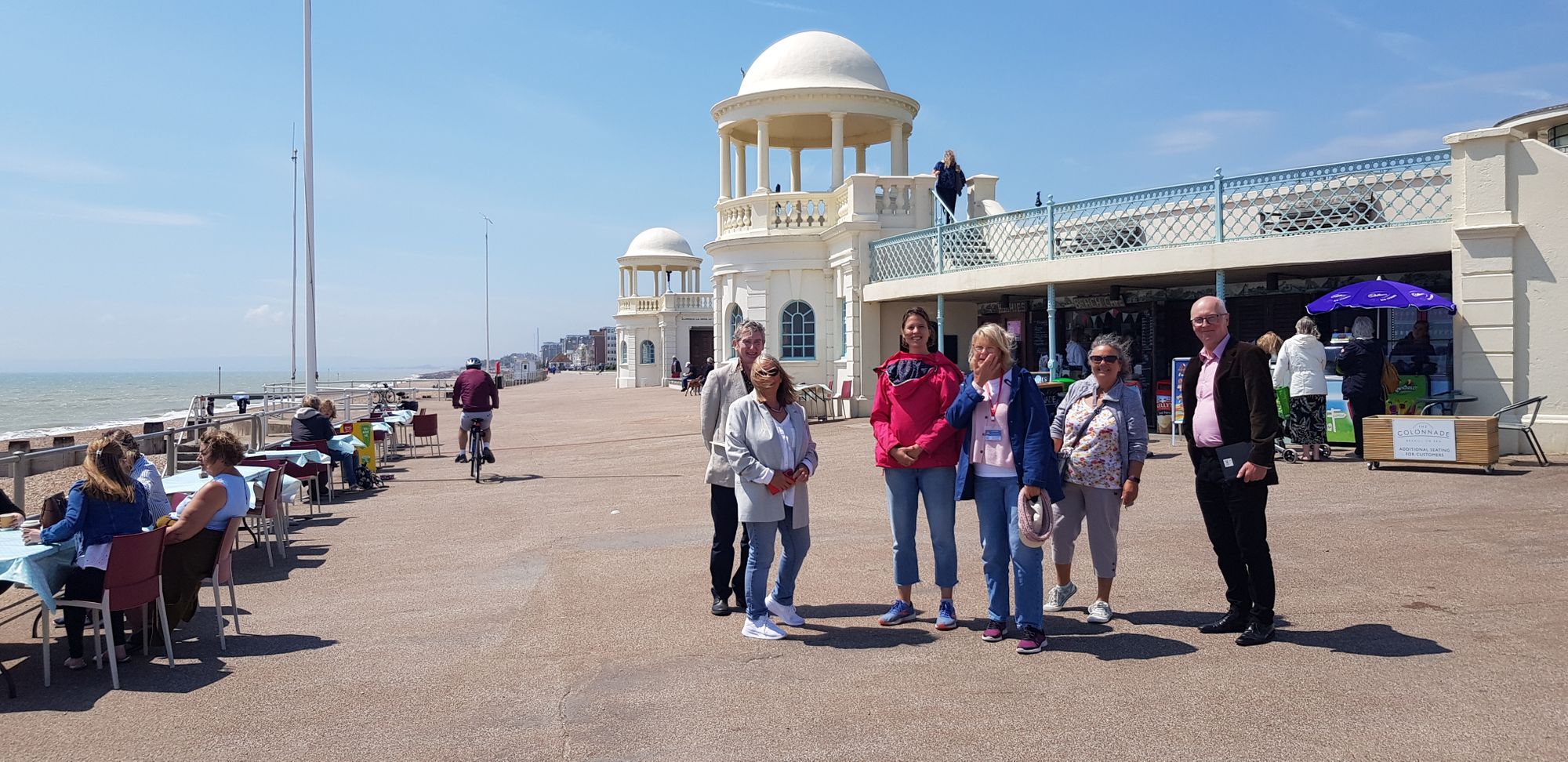The first ever Civic Revival sociable study tour on 9 July was a reminder of how delightfully enjoyable – and productive – it is to move from the Zoom screen back into the real world of interacting with real people in real places. A site visit or study tour is the very best, most memorable and impactful way of learning about new places, and face-to-face simply cannot be beat for developing relationships. It was an honour and privilege to meet some of the new councillors of Bexhill-on-Sea Town Council, to listen and learn from them, and to share thoughts with them.
Yet the event was also a sobering reminder that the Covid pandemic is still not over. Originally scheduled for eleven days after (the originally planned date for) the final lifting of all Covid restrictions on 28 June, we had hoped that the event could double up as a celebration by the seaside of the end of the pandemic. In fact, almost the reverse was the case: the decision was taken to hold the event despite the continuation of social distancing restrictions, in order to make the most of the short window before the Delta variant wave of Covid infections really let rip.
Thanks to the efforts of Viv Taylor-Gee and Rohan Jayasekera of Bexhill Museum we were able to offer a ‘hybrid’ event, with one hour of the afternoon session given over to a live Zoom link between the participants of the round table session at Bexhill Museum and people from across the country who for whatever reason were unable to attend in person. This was a technical success, and civic activists beaming in from places as far away as Northumberland, Somerset and South Gloucestershire were seen and heard loud and clear. The hybrid format perhaps points the way to how virtual and real life presence will be blended in the future.
Although the numbers attending in person were not large, what was lost in quantity was more than made up for in quality, as a wonderfully varied group of people, with different and complementary sets of knowledge and skills, assembled from places including Hastings, Southampton, Surrey and London. The organisers had hoped that the serendipity of unexpected connections and shared interests being discovered between people who have never met before would work its magic, and it did.
Bexhill-on-Sea Town Council
The story of Bexhill-on-Sea Town Council in East Sussex has been told by Civic Revival on our website here, and at the Empowering Our Communities event we co-hosted with Democracy4Bexhill in March 2021.
In short, on 6 May the first elections to the newly-established Town Council were held, after years of local campaigning for it to be established. All but one of those elected stood on a non-party political independent ticket, and this group of people is now learning how to work together to run a council, engage the community, and put their ideas for civic improvements into practice.
At Civic Revival we felt that Bexhill was an excellent example of the potential the parish/town council tier of government offers to improve places through local democratic leadership and civic action. Although it is very early days for the Town Council, which is completely new and has barely had time to do anything yet, we were keen to visit the town as soon as possible after the election: our logic being that the early days are as important as any in following an evolving story.
We also thought that a sociable day by the seaside on Britain’s sunniest stretch of coast wouldn’t go amiss in July, and we were not disappointed – the weather was perfect for study touring by foot: hazy sunshine, not too hot, not too cool.
The empowered local tier of government
Since the Localism Act 2011 established ‘the general power of competence’, parish and town councils have morphed from being a tier of local government with statutory responsibility for allotments and very little else, to being a local body that can do anything at all, so long as it is legal, and so long as the local electorate continue to support it.
When a parish or town council ‘sets its rate’ (precept on the council tax), every household in the town has to pay it. Therefore citizens have to decide through the ballot box at four yearly elections whether they want a council that charges next to nothing but does next to nothing, or whether they are willing to pay to get good things for their community collectively in a way that any individual citizen or household couldn’t do on their own.
‘Taxation with representation’: such an absolutely basic principle of local democracy that would be completely familiar to any American (or indeed citizen of almost any country), but which almost seems weird to us in England with our large, impersonal district and county councils that are mostly obliged to dance to central government’s tune. Because Fleet Street and the BBC tend to report local elections purely in terms of how they affect the national political scene and the big political parties, the general level of public understanding about what local democracy is, and how it works, is woefully low.
Among the 10,000 or so parish and town councils in England, very few have taken dramatic advantage of the opportunity offered by the Localism Act. Some have however, including those that have followed the example set by Frome, Somerset. Bexhill wanted to join in but needed to get a town council established to do so, a process that took much longer than originally expected. But Bexhill got there in the end, and a new chapter in the story has now commenced.
The sociable side
Civic Revival was also keen to give attendees a sociable time, after many long months of Zoom meetings. Because Bexhill is located in the south eastern corner of the country, too far away for a day trip for many, an evening social was organised for the night before the main study tour, which was held at Bexhill’s excellent Trattoria Italiana.
The very best kind of a traditional, family-owned and staffed Italian restaurant, the food and the welcome (and the aperitivi) could not have been better. The fact that the all-important England–Italy Euro 2020 final was only 72 hours away only added to the jovial atmosphere. The potluck approach to who attended was rewarded with the company of the leader of the Business Improvement District of one of England’s major cities and a representative of the marvellous Ctrl-Shift Summit.
For the opening of the study tour on the Friday morning, morning coffee at Bexhill’s showpiece De La Warr Pavilion had been planned. Unfortunately, due to Covid restrictions, this had to be done independently rather than in a single group, but the tour kicked off at the main entrance of the pavilion promptly at 11am with a welcome by Councillor Viv Taylor-Gee of Bexhill-on-Sea Town Council.
The first port of call was the splendidly quirky Bexhill Museum, for the story of the campaign to set up the Town Council by Viv Taylor-Gee, and a lecture on the history of Bexhill-on-Sea by the museum’s curator, Julian Porter.

The history of Bexhill-on-Sea
Bexhill (now known as the Old Town) is an ancient Sussex village dating back to AD 772, but what we know as Bexhill-on-Sea was developed specifically as a seaside resort quite late in the Victorian era by the local aristocrat Reginald Sackville, 7th Earl de la Warr. The Earl’s plan was not so much to rival Brighton or Eastbourne, but to give the Sussex coast a resort to rival Nice or Cannes on the Cote d’Azur. In some respects he succeeded, but he didn’t manage to make the resort completely exclusive: his developer John Webb was given the land to the west of Sea Road as part-payment, and Webb laid out the grid of streets south of the railway station that makes up what is now the town centre of Bexhill. This part of town was developed for more of a mass market.
The walking tour of these streets revealed a town centre which owes much to the Edwardian era’s mastery of simple but functional and elegant urban design. The showpiece main street of Devonshire Road is a parade or boulevard of three and four storey buildings with shop units at ground level and residential above, and several of the lesser streets crossing and parallel to it are similarly arranged. One member of the tour party was reminded of Surbiton.
Now, over a hundred years later, Bexhill could be argued to be cursed by too many small shop units for modern retail habits. Or, as Viv Taylor-Gee noted, it could be argued to be blessed by them. Mostly too small for the major chain retailers, Bexhill now has a very high proportion of independent retailers, and this potentially sets the town up very nicely for the ‘post-clone town’ era heralded by Bill Grimsey, Rebecca Trevalyan and many others. Bexhill is already a ‘15 minute city’ in which all essential shops, services and leisure facilities are no more than a 15 minute walk away (around ¾ mile).
On the other hand, some of the residences of Earl de la Warr’s exclusive resort have over the decades been turned into Houses in Multiple Occupation (HMOs) and like so many other English seaside resorts, there are many people in real social and economic deprivation in parts of the town.
The municipal history of Bexhill
Julian Porter’s lecture also provided a detailed municipal history of the town of Bexhill, highlights of which included fantastic archive photographs of great civic events in the history of Bexhill, including the opening of the new Town Hall, and the arrival by motor car of the royal charter to incorporate Bexhill as a municipal borough in 1902.
The first Mayor, Gilbert Sackville, the 8th Earl de la Warr, became the promoter of the first motor races in the UK (which were held along the seafront De La Warr Parade), giving Bexhill its proud claim of being the birthplace of British motor racing. The 9th Earl de la Warr, Herbrand Sackville, built the De La Warr Pavilion in 1935, and remains one of the best examples of pre-war modernist architecture in the country. It wasn’t popular locally at the time, but Bexhill residents have since warmed to it.
Herbrand Sackville was the first (and possibly the only ever?) socialist Mayor of Bexhill, and it makes for an interesting reflection on rural Sussex that a socialist only gets elected when the local aristocrat decides to take it up!
The 1974 local government reorganisation saw the demise of Bexhill Corporation. The anxiety of all places in Sussex near to Hastings not to “get put into” the sinful metropolis of Hastings, saw the creation of the half-doughnut shaped Rother District Council which surrounds Hastings and covers an area of 196 square miles reaching as far as the village of Battle (the location of the famous Battle of Hastings) and the ancient cinque port of Rye. Rother District Council took over Bexhill Town Hall, and it remains its headquarters to this day.
Now in 2021 Bexhill Town Council is back on the scene and the future of the 1974 ‘two tier’ system of shire counties and shire districts is in doubt. Many places have been moved or are being moved to a one tier unitary system. This includes most recently Somerset, Cumbria and North Yorkshire. But for the time being there are now three tiers of local government in Bexhill: East Sussex county, which runs the highways, the libraries, social services and more; Rother district, which is the planning authority, empties the bins and cleans the streets (among many other things); and Bexhill Town Council, which has a blank sheet of paper to do what it can to brighten the town.
The walking tour
The tour began with a walk from Bexhill Museum across Egerton Park, a classic municipal park with a boating lake, bowls club and tennis courts, all in good repair. The park was inherited by Rother District Council from the old Bexhill Corporation. It was named in honour of another aristocratic family intermarried with the Sackvilles, the Egertons of Cheshire (whose ancestor the Duke of Bridgewater was proprietor of Manchester’s famous pioneering canal).
The park also features Egerton Park Childrens Centre, built in the noughties by East Sussex County Council with funding from New Labour’s Sure Start nurseries programme, and closed by the county council at the end of 2020. The county council decided to provide means-tested grants to parents to buy places at other privately-run nurseries in the town, rather than run its own high standard facility.
A fine new building, it currently stands closed, with the county council apparently planning to let the building to the NHS. It could have made an excellent home for the Town Council, who could have been given the chance to show what they could do in terms of running such a building for the benefit of the community (making space for community health facilities amongst other things). A missed opportunity, perhaps.
We strolled under the Hastings to Eastbourne railway line to view the Town Hall and Town Hall Square, scene of the great civic pageants of the 1900s we had been shown by Julian Porter. The Town Hall is a very fine building, and the square and garden in front of it could be a very dignified civic space. However, a 1970s-era Sainsburys superstore presents a blank brick wall to its southern flank and the roadspace has been evolved to meet the needs of through traffic on the main London Road, and for on-street parking. The net result is rather depressing: from an Edwardian civic square an environment dominated by traffic engineering has been created.
It is therefore exciting to hear that East Sussex County Council is considering plans to change the layout of this square, hopefully so that it gives the building greater presence and pedestrians do not have to take their lives in their hands to get to the middle. No proposals appear to have been published yet. However, the howls of anguish from the town’s motorists should any change to parking arrangements be attempted can easily be imagined.
We then took a look at the commercial streets of Wickham Avenue, Sackville Road and Western Road, and its surfeit/abundant wealth of Edwardian commercial shop premises. One option for the new Town Council would be locate in disused shop premises, which would have the advantage of being prominent and accessible to the public. However, another school of thought is that the Town Council needs a larger building with a public hall, capable of holding gatherings and events, such as cinema nights.

On Wickham Avenue we stopped off for lunch at the Wickham Bistro, a relaxed, unpretentious, independent neighbourhood café-restaurant with good service, superb food and fair prices. The bistro is a great example of what is possible when independent businesses are allowed the space in the high street to do their thing. The personal touch, the historic premises sensitively re-used, the atmosphere of informal decorum without stuffiness, all add up to create something unique that a chain could never provide. Every neighbourhood deserves a Wickham Bistro: Bexhill has got one.
Alternatively, another way of viewing Wickham Bistro could be as a threatening vanguard of gentrification by “DFLs” – Down From Londoners. Bexhill is currently experiencing a residential property sales boom and soaring house prices. Traditionally it has always been a town for Londoners to retire to, but the very slow rail service to London (taking 2 hours via Eastbourne and Lewes) stopped it from being an attractive place to commute to London from daily. Now, with the Covid revolution in working from home, Bexhill is transformed into an attractive place to London office workers, offering (what seem to Londoners to be) low house prices, and reasonable access to the capital for, say, one or two trips per week. Any estate agent would tell you that for some incomers, a place like Wickham Bistro helps seal the deal: it helps create a place people want to live in.
Civic Revival is very interested in the social and economic dynamics of gentrification, and in particular to gain insight into how places can walk the difficult tightrope between having inadequate new blood and new investment, and being spoilt by incomers with fat wallets and bad attitudes. The answer lies somewhere in the concepts of community wealth-building, local civic values, and protection from extractive and exploitative ownership models, but of course it isn’t easy. The question posed by the study tour was whether a town council can help Bexhill navigate these complex waters, and the answer to that is surely, Bexhill is certainly giving it a try.
The walking tour rounded off with a walk back down to the seafront, to the site of the 8th Earl’s Kursaal assembly room (now long demolished) and back past the 9th Earl’s Pavilion to the Bexhill Museum for a round table session to discuss what we had seen and to link up live with local democratic civic leaders and activists from across the country by the wonder of Zoom.
The round table session
The session was attended by the study tour group and four Bexhill town councillors: Viv Taylor-Gee, David Harding, Lynn Brailsford and Richard Thomas. There was time for everybody attending to say a little about themselves and for each of the councillors to nominate the one thing they hoped to be able to achieve for Bexhill as a town councillor.
Then it was time for the link up on Zoom, which featured inspiring contributions from:
- Peter Macfadyen, doyen of community self-governance at the human scale, author of Flatpack Democracy 2.0: Power Tools for Reclaiming Local Politics, and key player in the Flatpack 2021 campaign to elect more pro-active town and parish councils;
- David Beaman, independent town councillor in Farnham, Surrey;
- Wendy Breach, of the Flatpack-inspired Open Hexham group that enjoyed success at the May 2021 elections to Hexham Town Council, Northumberland;
- Peter Tyzack, Chair of Pilning and Severn Beach Parish Council in South Gloucestershire.
Peter Stonham of Civic Revival wrapped up the session and thanked Viv Taylor-Gee and her colleagues for hosting the first Civic Revival sociable study tour. He stressed the need for kindred spirits in different places to be able to communicate and keep in touch with each other in their journey to encourage positive community engagement in civic affairs and making better places. There will be more Civic Revival sociable study tours when the pandemic dies down, and through this and the Civic Revival website, we will try to play our part in facilitating the process of knowledge-sharing and morale-boosting to help develop the revival in local democratic civic leadership.


